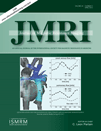Cross-sectional and In-plane coronary vessel wall imaging using a local inversion prepulse and spiral read-out: A comparison between 1.5 and 3 tesla
Abstract
Purpose:
To compare cross-sectional and in-plane coronary vessel wall imaging using a spiral readout at 1.5 and 3 Tesla (T).
Materials and Methods:
Free-breathing coronary vessel wall imaging using a local inversion technique and spiral readout was implemented. Images were acquired in ten healthy adult subjects on a 3T clinical scanner using a 32-element cardiac coil and repeated on a 1.5T clinical scanner using a 5-element coil.
Results:
Cross-sectional and in-plane spiral vessel wall imaging was performed at both 1.5 and 3T. In cross-sectional images, artifact scores were superior at 1.5T (P < 0.05) but no significant difference was found in image quality scores compared with 3T. Image quality (P < 0.01) and artifact scores (P < 0.01) were found to be superior for in-plane images at 1.5T. Vessel wall sharpness in the in-plane orientation was also found to be higher at 1.5T (P < 0.03).
Conclusion:
Although excellent in-plane coronary vessel wall images can be acquired at 3T, the overall robustness may be affected by off-resonance blurring due to increased B0 inhomogeneity compared with 1.5T. J. Magn. Reson. Imaging 2012;35:969–975. © 2011 Wiley Periodicals, Inc.




